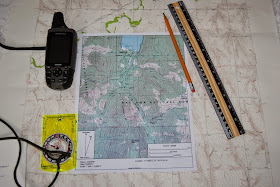Universal
Transverse Mercator (UTM) is a grid system that describes a person’s geographic
location in the backcountry. It is
simple to understand and use because:
1. It is intuitive - it’s concepts can be understood quickly,
2. It can be easily self taught,
3. Young hikers grasp this system easily,
4. A location on a map can be quickly determined, and;
5. It is a selection option for Global Positioning System (GPS) receivers.
2. It can be easily self taught,
3. Young hikers grasp this system easily,
4. A location on a map can be quickly determined, and;
5. It is a selection option for Global Positioning System (GPS) receivers.
A
navigation grid is a reference system developed by cartographers that can be
used to plot a geographic position on a map.
There are many grid systems
available for use such as Latitude and Longitude and Universal Transverse
Mercator (UTM). Several countries have
their own national grid system.
The
UTM system is just like a Cartesian Grid.
For example, the grid position below is just 2.2 units over and 2 units
up.
To
understand the complete grid we will start by observing that the globe is divided
into 60 zones. Each zone is 6° of
longitude wide. Each zone runs north and
south; 84° north to 80° south.
The
image below highlights the UTM zones in the continental United States.
UTM grid consists of Northings and Eastings. The image below highlights the complete layout of a UTM zone. Notice the Central Meridian that runs north and south through the zone. Like longitude, this meridian runs from pole to pole. All values for measuring position are in meters. At the equator the zone is 500,000 meters wide. The width of the zone is described by Eastings. Northings run north or south from the equator; again all values are in meters.
UTM
coordinates are presented such that the zone is listed first, followed by the
Easting and then the Northing.
10 0524120 E
4891555 N
The
hiker should think of a grid as a series of defined squares on a map (see
below.) On a 1:24,000 scale (7.5 minute
topographic quadrangle) the grid lines are 1000 meters apart; north or south
the spacing between grid lines is 1000 meters.
The
coordinate values are known Easting’s (vertical lines) and Northing’s (horizontal
lines.)
Easting values increase moving from left to right
and Northing’s increase from bottom to top.
Coordinate values are always positive.
Every location will have a
zone identifier. On the map above the
zone is linked to the Easting value and is the first set of numbers. In this case the zone identifier is the
number 10.
The letter “T” seen above is a secondary, horizontal
(east-west) identifier. I personally pay
little attention to it in my backcountry trips.
All USGS maps identify the zone in the title block at the bottom
left of the map. Note that on some
commercial maps the UTM zone identifier may not be in the title block and can
be hard to find.
The UTM coordinate can now be refined to a meter. Again the spacing between the grid lines is
1000 meters (1 kilometer). On the maps below,
the tick marks between gridlines are in increments of 100 meters. The hiker can then interpolate the distance
between the tick marks.
The
position of the large X on the map above would be described as:
10 5 25 270 East (the green line)
47 91 180 North (the red line)
The
final three places will always be expressed (10 5 25 270 East.) The value 2 is in units of hundreds, the 7 is
in units of 10 and the 0 is in units of 1’s.
Thus, 50 meters would be written
as 050.
Every
point on a map (e.g., a mine, an intersection, a camp site, etc) can be
described using UTM coordinates to the accuracy of one square meter.
I
recommend consider carrying a small plastic ruler or other suitable straight
edge when accuracy is important. For
general hiking and backpacking, one can quickly estimate a current position in
the backcountry without other map tools.
UTM
coordinates of a destination taken from a map can be easily saved on a GPS
receiver. For example, to do this the
hiker “marks” a waypoint and then moves the backlit bar (yellow shaded area)
from “save” to the “location” data field.
The “location” data field is then edited per the receiver’s instruction
manual.
A
fine reference for more practical information about UTM grid is Lawrence
Latham’s book GPS Made Easy. Chapter 5 has an easy to understand tutorial
on this grid system; that’s how I learned it.










UTM works great if your area is all in one zone. When your area includes a zone boundary, things are not so simple.
ReplyDelete